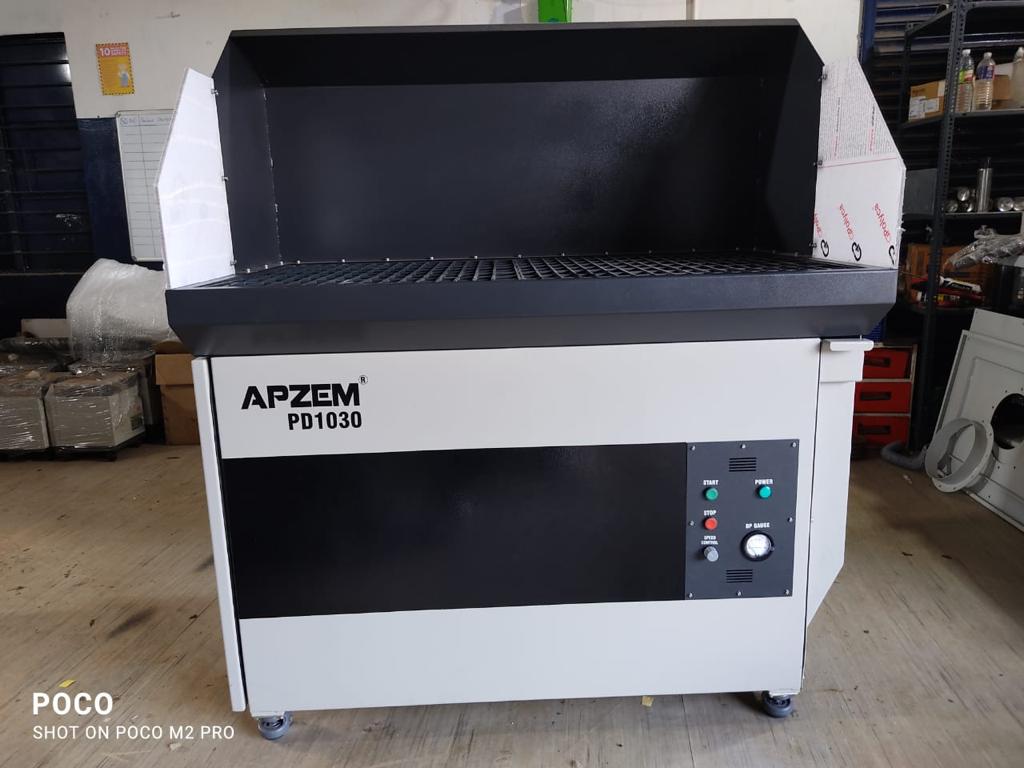Specifications:
| BASIC DETAILS |
|
| SUCTION CAPACITY (CMH/CFM) |
1500/880 |
| DIMENSION |
OVERALL SIZE: 1490 (L) X 930 (W) X 1700 (H) in mm
WORK TABLE SIZE: 1370 X 770 in mm |
| MOTOR POWER |
3 HP |
| MOTOR SPEED |
2840 RPM |
| POWER SUPPLY |
3 PHASE / 50Hz |
| RATED CURRENT |
3.6 A |
| NOISE LEVEL |
< 83dB |
| STATIC PRESSURE |
150mm of WG |
| FILTER CLEANING |
AUTOMATIC PULSE CLEANING |
| FILTER DETAILS |
|
| FILTER SURFACE |
21 sq.m (227 sq. ft.) |
| TYPE OF FILTER |
CARTRIDGE FILTER |
| FILTER MATERIAL |
Cellulose and Polyester Blend with Nano Fibre (Fire Retardent) |
| FILTER EFFICIENCY |
99.9% @ (For 0.2 to 2 microns) |
Accessories:
Cartridge filter
Castor wheel
Warranty:
1 year from Installation date
Frequently Asked Questions
A downdraft table is a specialized work surface equipped with a built-in ventilation system that pulls airborne contaminants, such as dust, fumes, and smoke, downward through the table's surface. It is commonly used in woodworking, metalworking, and various industrial processes to provide a cleaner and safer workspace.
The downdraft table uses fans and filters to create a downward airflow over the work surface. When tools or processes generate contaminants, they are drawn into the table through small openings or slots on the surface. The contaminants are then filtered before clean air is released back into the workspace.
Improved air quality, Enhanced safety, Versatility
Downdraft tables can capture a wide range of airborne contaminants, including dust, wood particles, metal shavings, welding fumes, soldering smoke, grinding dust, and various other particulate matter generated during industrial processes.
The airflow in a downdraft table is typically regulated through the use of adjustable fans and dampers. Users can control the fan speed and adjust the dampers to balance the airflow across the work surface based on the specific application and the amount of contaminants being produced.
Yes, downdraft tables can be used in residential settings, especially for DIY enthusiasts who engage in woodworking or other hobbies that produce airborne particles. However, it's essential to choose a downdraft table that fits the scale of the work and the types of contaminants produced.
The frequency of filter replacement depends on the usage and the type of contaminants being captured. Generally, filters should be inspected regularly, and replacement intervals can range from a few months to a year or more, depending on the specific application and filter type.
Some downdraft tables are designed to be portable, while others are more stationary or integrated into workbenches. Portable models often have wheels or casters, making them easy to move around the workspace as needed.
Downdraft tables can be used with various tools and equipment, including saws, grinders, sanders, and other machines that produce airborne contaminants. They can also be customized to suit specific applications and workstations.
Regular maintenance is essential to keep a downdraft table functioning optimally. This includes cleaning the surface and filters regularly, inspecting the fan and ventilation system, and replacing filters when they are worn out. Additionally, following the manufacturer's maintenance guidelines is crucial to ensure the longevity of the equipment.
